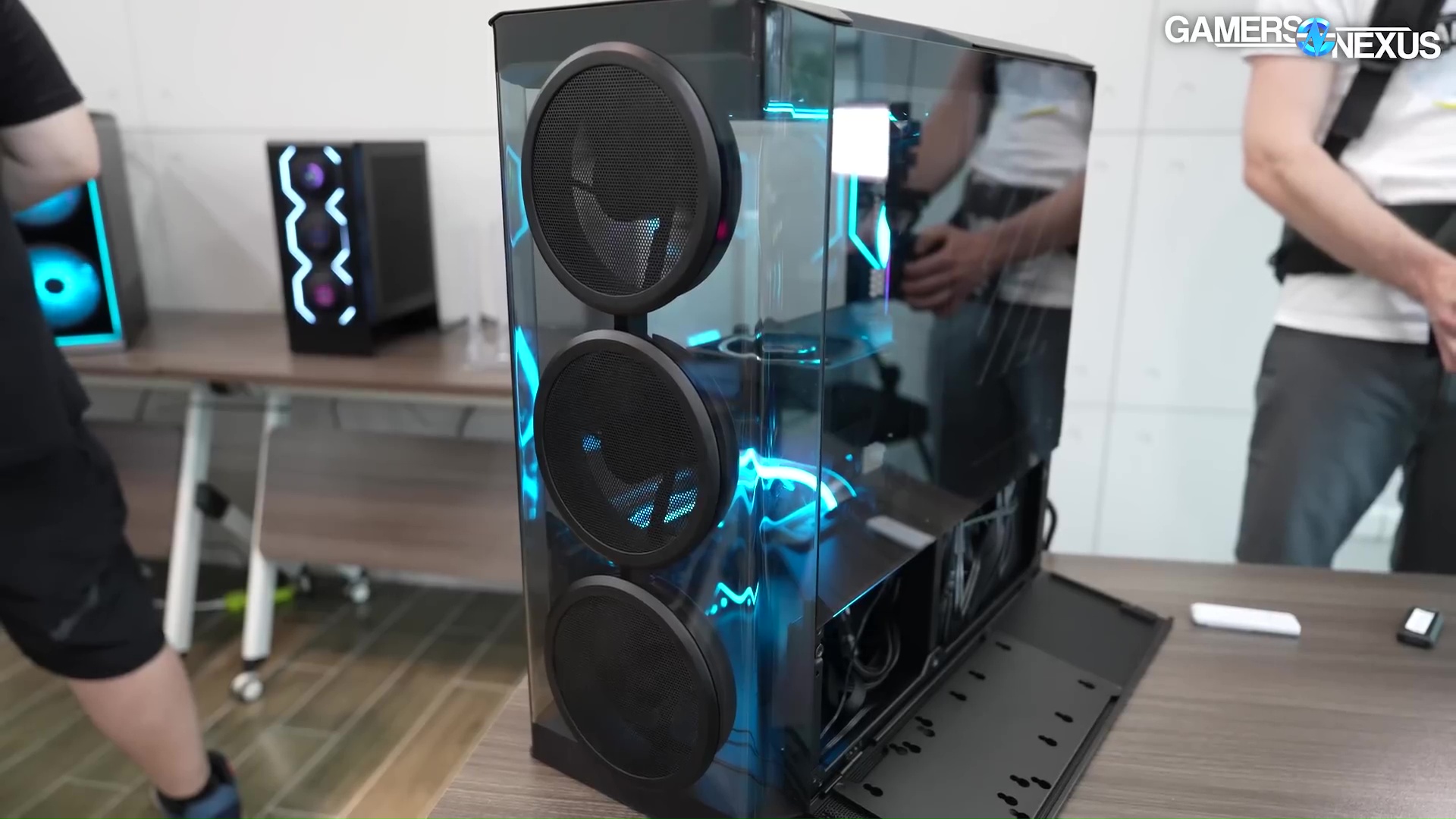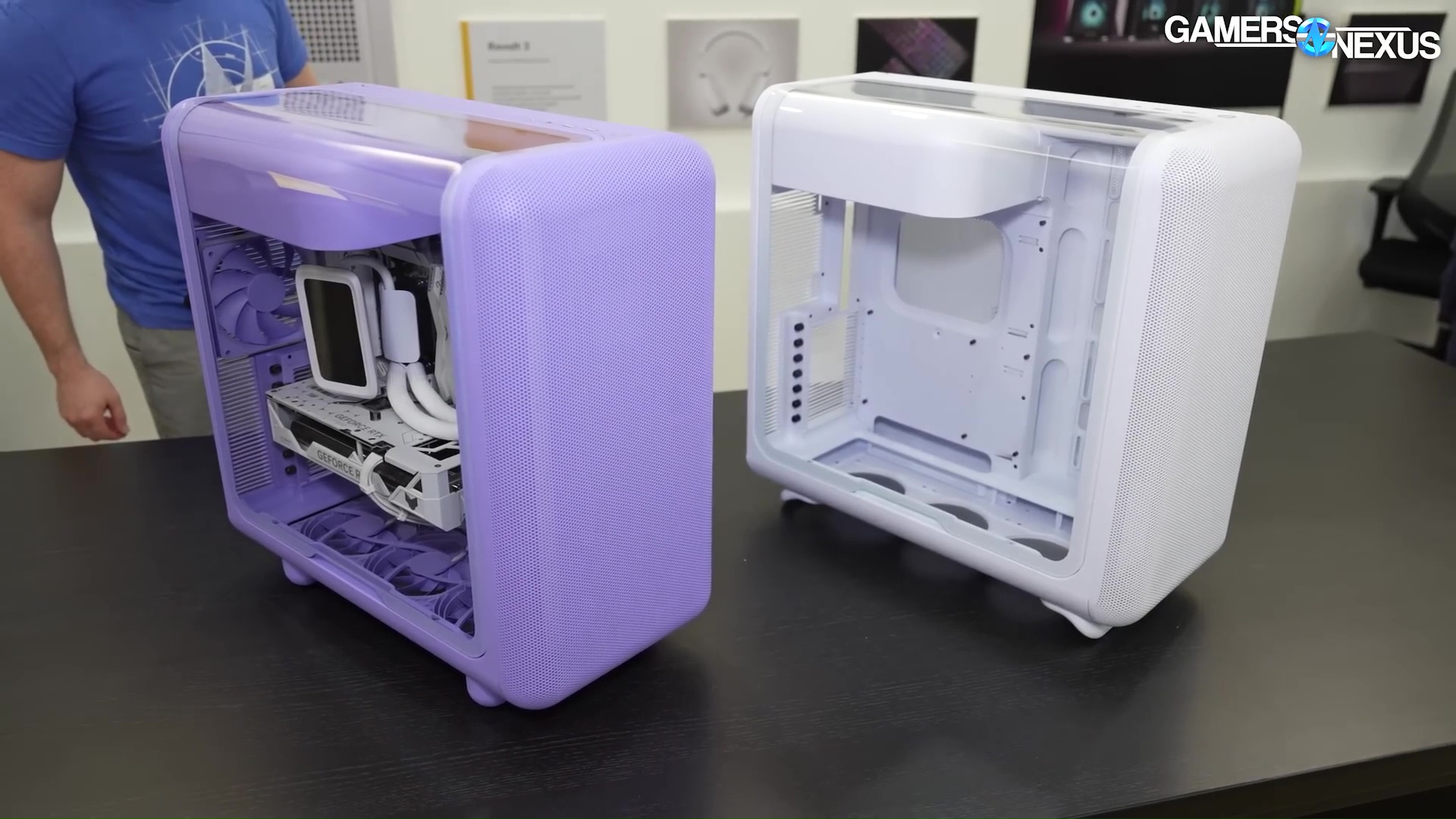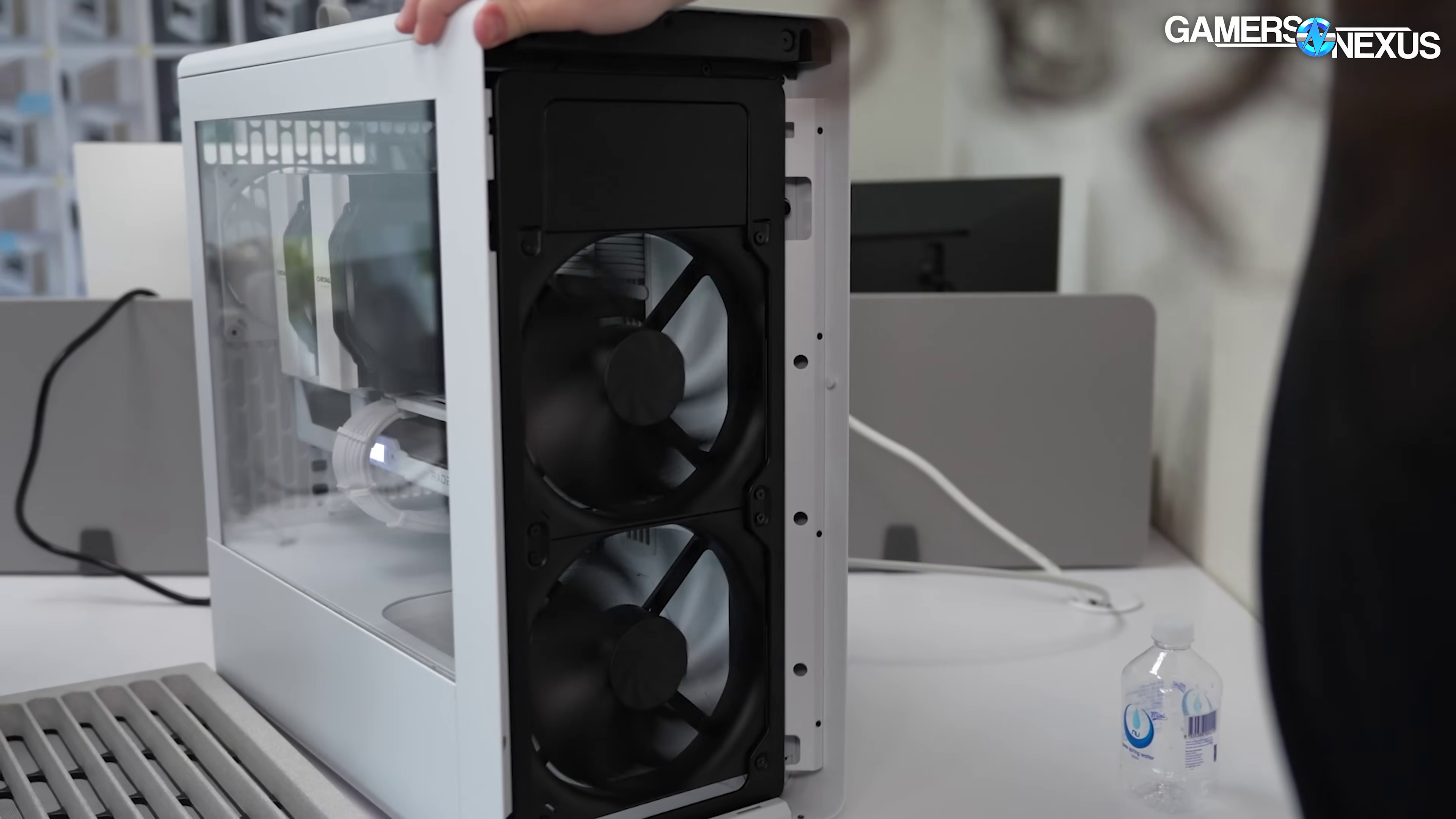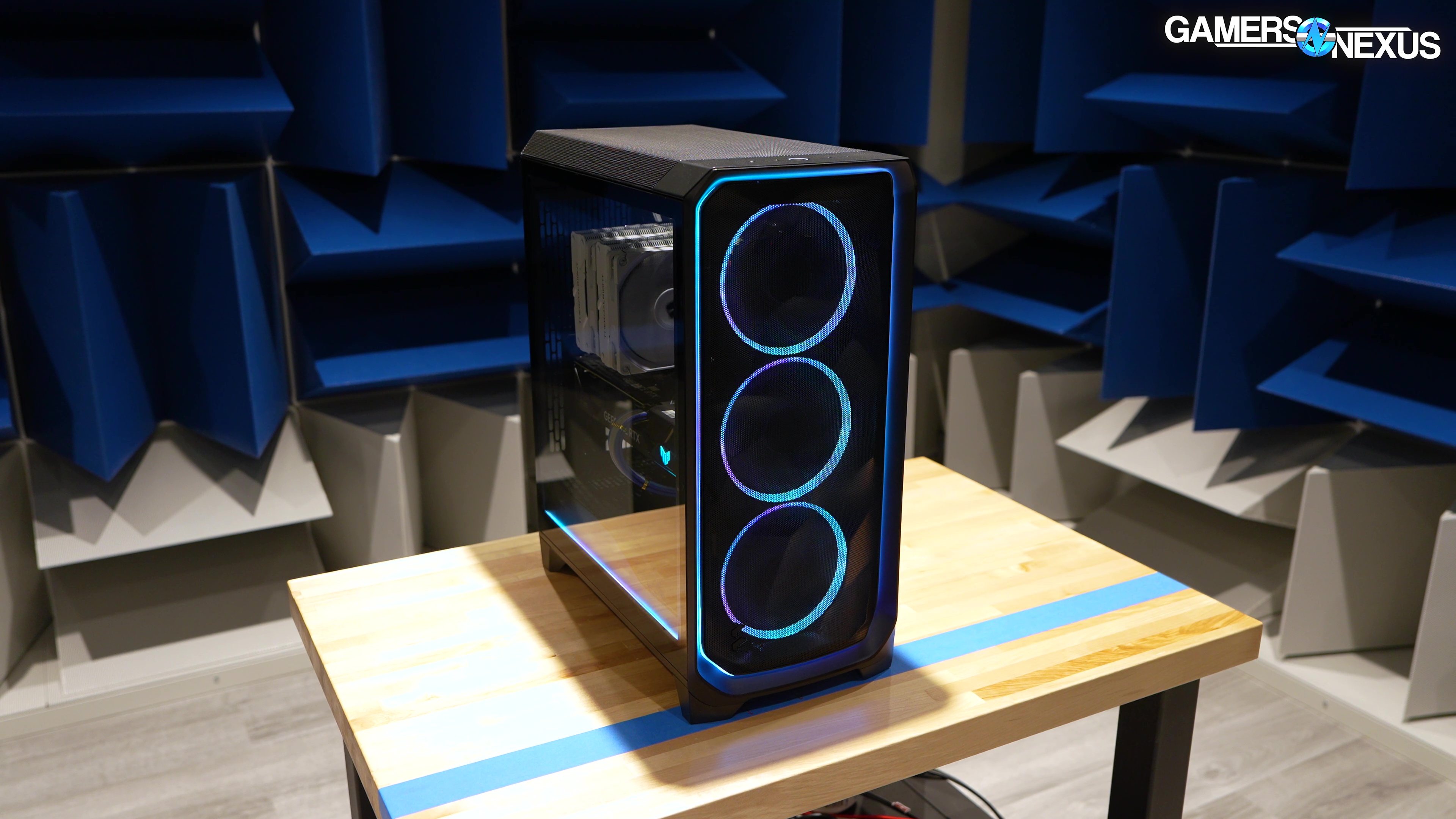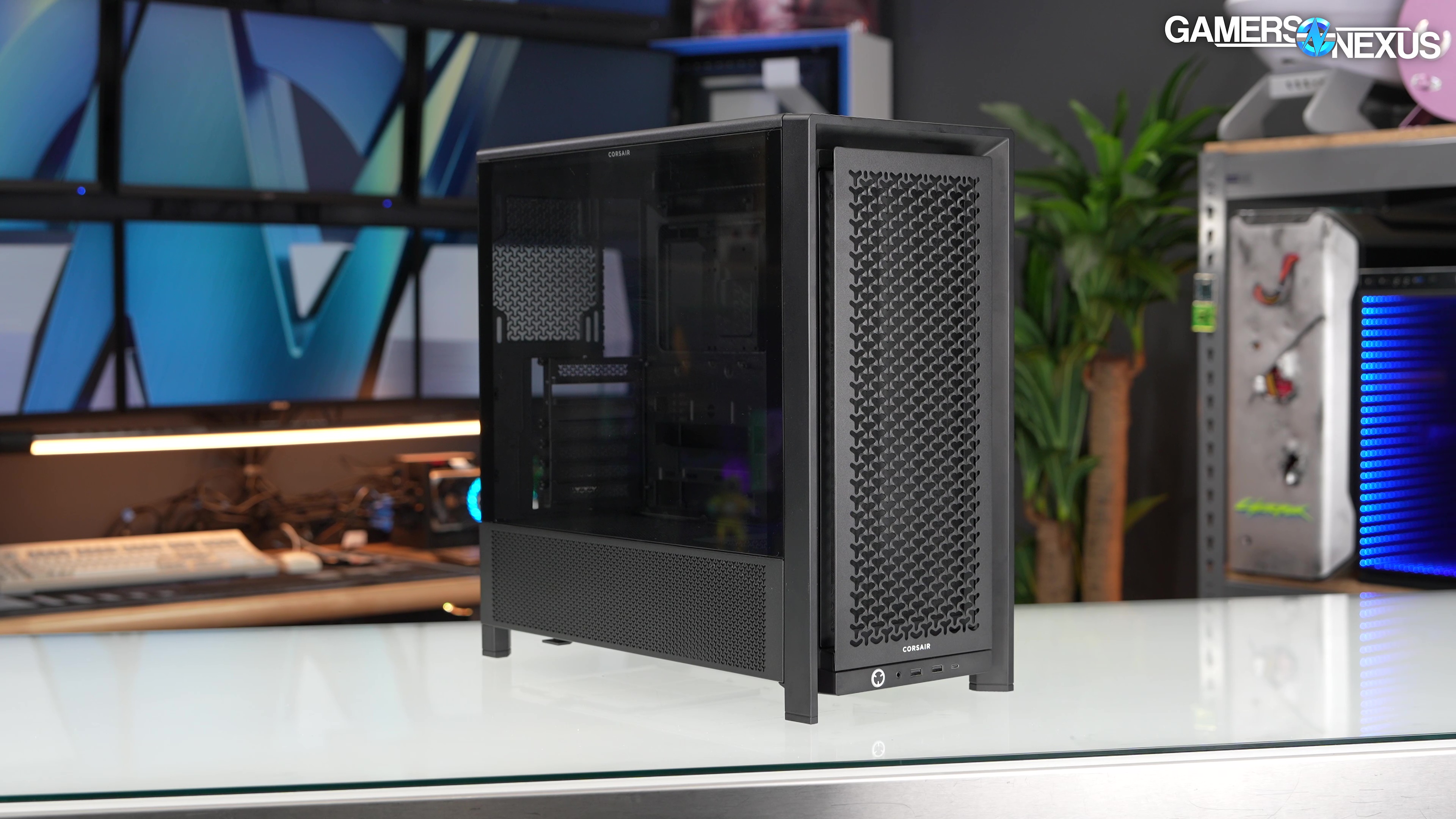MSI MPG Velox 300R Airflow PZ
Pros
Supports multiple big radiatorsExcellent dust filtrationSpace for open-loop cooling components
Cons
Not fully EATX-compliantMidpack thermal performance in our tests
MSI MPG Velox 300R Airflow PZ Specs
120mm or 140mm Fan Positions
10
120mm to 200mm Fans Included
3
Dimensions20.6 by 9.3 by 19.5 inches
Fan Controller Included?
Front Panel Ports
HD Audio
Front Panel Ports
USB 3.2 Gen 1 Type-AFront Panel Ports
USB 3.2 Gen 2 Type-C
Included Fan Lighting Color
Addressable RGB
Internal 2.5-Inch Bays
5
Internal 3.5-Inch Bays
2
Internal Chassis Lighting Color
None
Maximum CPU Cooler Height
165
Maximum GPU Length
400
Motherboard Form Factors Supported
ATX
Motherboard Form Factors Supported
MicroATX
Motherboard Form Factors Supported
Mini-ITX
PCI Expansion Slot Positions
7
Power Supply Form Factor Supported
ATX
Power Supply Maximum Length
260
Power Supply Mounting Location
Bottom
Side Window?
YesWeight
23.5
All Specs
MSI has built a formidable reputation over the past four decades, beginning with motherboards and working its way through servers and graphics cards before finally becoming a premier laptop manufacturer. Its name is synonymous with shopping for PC components, but its PC cases usually come to mind only when we think of its prebuilt desktop machines. Built from sturdy materials and loaded with popular features, its MPG Velox 300R Airflow PZ is designed to leave a more lasting impression. Supporting MSI’s reverse-connector Project Zero motherboards and smartly designed for accommodating a substantive build that’s air- or liquid-cooled, the Velox is a worthy rival to Asus’ TUF Gaming cable-hiding case. PC builders weighing a Project Zero build to minimize visible cabling should shortlist this chassis, though the selection of reverse-connector-compatible PC cases is growing fast.Design: Packing in the Features for Project ZeroWith a sturdy steel structure making up most of its 23.5 pounds of heft, the MPG Velox 300R Airflow PZ is as weighty as its name is long.Its numerous strengths include dust filters that cover every air inlet, giant 160mm ARGB intake fans connected to a factory-installed controller/hub, and even a logo-emblazoned low-restriction faceplate that will probably help make any dust that collects on the filter behind it slightly less noticeable as the PC waits for its next cleaning. A light tint on the 4mm-thick tempered glass side panel makes the black 120mm exhaust fan harder to spot against the case’s black interior. Mounted on four snaps and three guide pins, the faceplate easily pulls away to access the front panel’s plastic-framed nylon-sheet dust filter. Secured with three magnets on each side, the filter pulls easily away from the fans for cleaning.Though “front-panel” ports and buttons often end up on the top panel of modern cases, the Velox 300R’s placement is somewhat unusual in that it’s a bit farther away from the actual front of the case than on most cases. Lined up along its right edge are a power button with a power-indicator LED window, an LED mode button, a headsetcombo jack, two USB 3.2 Type-A ports, and a Gen 2x2 Type-C port. Unfortunately, there’s no reset button or drive-activity light.The rear panel features the only Velox 300R vents that aren’t covered in dust filters, though that’s okay; these should probably be viewed as exhaust vents that flow filtered air from those big front-panel fans. We also see the ATX standard’s seven expansion slots, a 120mm exhaust fan screwed onto slots that allow a little vertical adjustment, a power supply mount with two sets of holes to allow inverted mounting, and two vertical vent sections running up the forward and rear portions of the right side panel.The expansion-slot panel is inset, which simplifies graphics card installation. A long dust filter that covers most of the bottom panel slides out the back of the case from beneath the power supply bay.The top panel and two long side panel vents are each covered internally with a perforated metal filter sheet, each of which uses magnetic tape around its periphery to stick to the steel panel.The Velox 300R’s top panel is designed to hold a 360mm-format radiator up to 420mm long.The Velox 300R’s top panel also includes a second set of mounting slots to enable three 140mm fans to be placed there instead.From this angle, we can also see that the power supply cover has two 120mm fan mounts, that an adjustable card brace is attached slightly forward of the power supply cover, and that a removable multi-purpose bracket is factory-mounted to the 120mm fan location at the front of the case’s bottom panel. The bracket is drilled to hold a single 3.5-inch or 2.5-inch drive, as well as a variety of open-loop liquid-cooling pump/reservoir combos.Like the multifunction bracket that sits in front of it, the outer three-quarters of the power supply cover is removable. That fact eased the installation and removal of modular cables on our power supply.The Velox 300R’s motherboard tray includes several extra pass-through holes designed to fit the connector locations of MSI’s Project Zero motherboards, but they are not excluded, in any way we can see, from otherwise supporting its largest competitor’s rear-facing-connector design, Asus BTF. A side mount that can hold up to three 120mm fans and/or 360mm-format radiators up to 440mm long is offset an inch behind the motherboard tray, so that a fan up to 38mm thick could fit behind an EATX motherboard if we add the length of the standoffs to that thickness. We wouldn’t call the Velox an EATX case, because it has no mechanical support to hold 13-inch-long boards, but some slightly bigger-than-ATX boards will fit without requiring such supports.Behind the Velox 300R’s motherboard tray are its ARGB controller/fan hub and two drive trays.The controller’s hub supports four PWM fans and four ARGB devices.Removing the plastic plugs above and below the front-face 160mm factory ARGB fans allows us to see that the fan rails running up and down the face are also removable. Had we also removed the factory-fitted 160mm fans themselves, we could have used the extra mounting holes you can see to move the brackets inward to 140mm or 120mm fan spacing. The 480mm of spacebehind that mount exceeds the length of any 420mm-format radiator we’ve seen, so you could put a really big radiator up front if you so desire. That said, you'll probably want to keep these oversized fans if you are air cooling; they have a nifty design, with an offset circle of blades inside a larger circleThe drive trays include one dual-2.5-inch tray without 3.5-inch provisions and one with 3.5-inch provisions. Installing a 3.5-inch drive fitted with vibration-damping grommets precludes the use of any 2.5-inch drives in the second tray.Recommended by Our EditorsBuilding With the MSI Velox 300RLet's dig into the accessory kit. The Velox 300R includes an installation guide and a case sticker, four combo-head power supply screws, a Phillips-to-hex-adapter socket for installing standoffs, two spare standoffs, and lots of additional screws. These include 21 standard M3 screws, eight M3 and four #6-32 shoulder screws, and 12 extra-long #6-32 screws. You also get a bag of six replacement snaps for the ball-snap side-panel attachments, and two hook-and-loop and six zip-style cable ties.Case cables include a 19-pin USB 3.2 Gen 1 for the Type-A ports, a Type-E Gen 2x2 for the Type-C port, and an F_PANEL combo cable with breakout pins for a reset button that the case itself lacks. The ARGB controller/fan hub accepts PWM and ARGB control signals from the motherboard and is powered by a SATA-style power cable from your PSU.Our standard ATX motherboard fit the Velox 300R perfectly, and its card brace slid up to meet the edge of our test graphics card’s fan bracket nicely.The ARGB controller defaults to obeying the motherboard’s signal whenever its ARGB input is connected to the motherboard, but those who won’t be using motherboard control can also scroll through the controller’s inbuilt patterns via its mode button or even disable lighting entirely simply by holding the button for a few seconds.Here’s how the Velox looked all fleshed out with our standard test parts...MSI also sent along one of its motherboards, based on the Z790 chipset, so we could show this PZcase built with its cable concealment fully deployed. This photo shows how all the cable headers that would have been pointing outward on a traditional motherboard point backward on this model.We’ll have to push some of those ARGB fan controller/hub cables aside to reach the ARGB and ATX12V headers of the Z790 Project Zero motherboard.We’ll also have to stuff away a little more cable length since most of our cables are no longer required to reach around to the front of the board.Though the displaced power and data cabling cleaned up the show side of our build nicely, we still have our graphics card’s supplemental power cableand our AIO CPU cooler’s tubes to contend with. Still, mighty clean and almost "Zero."And though the Z790 Project Zero motherboard has far less lighting than the board from our standardized kit, some would argue that it still looks better thanks to the reduced cable clutter.Testing the MSI Velox 300R: Twice-Benchmarked, Once With Project ZeroHere’s a list of the internal components from both of the above-photographed builds, along with the settings we used for our tests.The Velox 300R’s thermal performance is exactly mid-pack when using our standard test kit, and swapping in the rear-connector motherboard only resulted in a faster-warming voltage regulator. Its temperature control falls behind its most direct competitor, the Asus TUF Gaming GT302 ARGB, in both configurations.The reason the Velox 300R’s cooling performance fell behind the Lian Li Lancool 207 and GT302 ARGB appears fairly obvious when observing our noise charts: It’s quieter than both those cases.Both companies were aware that they could get better thermal results simply by spinning their fans a little harder, but MSI appears to have favored a quieter approach. Be aware that simply enabling the automatic fan profiles for your motherboard could potentially put all three of these cases into a tie with regard to both temperature and noise.
#msi #mpg #velox #300r #airflow
MSI MPG Velox 300R Airflow PZ
Pros
Supports multiple big radiatorsExcellent dust filtrationSpace for open-loop cooling components
Cons
Not fully EATX-compliantMidpack thermal performance in our tests
MSI MPG Velox 300R Airflow PZ Specs
120mm or 140mm Fan Positions
10
120mm to 200mm Fans Included
3
Dimensions20.6 by 9.3 by 19.5 inches
Fan Controller Included?
Front Panel Ports
HD Audio
Front Panel Ports
USB 3.2 Gen 1 Type-AFront Panel Ports
USB 3.2 Gen 2 Type-C
Included Fan Lighting Color
Addressable RGB
Internal 2.5-Inch Bays
5
Internal 3.5-Inch Bays
2
Internal Chassis Lighting Color
None
Maximum CPU Cooler Height
165
Maximum GPU Length
400
Motherboard Form Factors Supported
ATX
Motherboard Form Factors Supported
MicroATX
Motherboard Form Factors Supported
Mini-ITX
PCI Expansion Slot Positions
7
Power Supply Form Factor Supported
ATX
Power Supply Maximum Length
260
Power Supply Mounting Location
Bottom
Side Window?
YesWeight
23.5
All Specs
MSI has built a formidable reputation over the past four decades, beginning with motherboards and working its way through servers and graphics cards before finally becoming a premier laptop manufacturer. Its name is synonymous with shopping for PC components, but its PC cases usually come to mind only when we think of its prebuilt desktop machines. Built from sturdy materials and loaded with popular features, its MPG Velox 300R Airflow PZ is designed to leave a more lasting impression. Supporting MSI’s reverse-connector Project Zero motherboards and smartly designed for accommodating a substantive build that’s air- or liquid-cooled, the Velox is a worthy rival to Asus’ TUF Gaming cable-hiding case. PC builders weighing a Project Zero build to minimize visible cabling should shortlist this chassis, though the selection of reverse-connector-compatible PC cases is growing fast.Design: Packing in the Features for Project ZeroWith a sturdy steel structure making up most of its 23.5 pounds of heft, the MPG Velox 300R Airflow PZ is as weighty as its name is long.Its numerous strengths include dust filters that cover every air inlet, giant 160mm ARGB intake fans connected to a factory-installed controller/hub, and even a logo-emblazoned low-restriction faceplate that will probably help make any dust that collects on the filter behind it slightly less noticeable as the PC waits for its next cleaning. A light tint on the 4mm-thick tempered glass side panel makes the black 120mm exhaust fan harder to spot against the case’s black interior. Mounted on four snaps and three guide pins, the faceplate easily pulls away to access the front panel’s plastic-framed nylon-sheet dust filter. Secured with three magnets on each side, the filter pulls easily away from the fans for cleaning.Though “front-panel” ports and buttons often end up on the top panel of modern cases, the Velox 300R’s placement is somewhat unusual in that it’s a bit farther away from the actual front of the case than on most cases. Lined up along its right edge are a power button with a power-indicator LED window, an LED mode button, a headsetcombo jack, two USB 3.2 Type-A ports, and a Gen 2x2 Type-C port. Unfortunately, there’s no reset button or drive-activity light.The rear panel features the only Velox 300R vents that aren’t covered in dust filters, though that’s okay; these should probably be viewed as exhaust vents that flow filtered air from those big front-panel fans. We also see the ATX standard’s seven expansion slots, a 120mm exhaust fan screwed onto slots that allow a little vertical adjustment, a power supply mount with two sets of holes to allow inverted mounting, and two vertical vent sections running up the forward and rear portions of the right side panel.The expansion-slot panel is inset, which simplifies graphics card installation. A long dust filter that covers most of the bottom panel slides out the back of the case from beneath the power supply bay.The top panel and two long side panel vents are each covered internally with a perforated metal filter sheet, each of which uses magnetic tape around its periphery to stick to the steel panel.The Velox 300R’s top panel is designed to hold a 360mm-format radiator up to 420mm long.The Velox 300R’s top panel also includes a second set of mounting slots to enable three 140mm fans to be placed there instead.From this angle, we can also see that the power supply cover has two 120mm fan mounts, that an adjustable card brace is attached slightly forward of the power supply cover, and that a removable multi-purpose bracket is factory-mounted to the 120mm fan location at the front of the case’s bottom panel. The bracket is drilled to hold a single 3.5-inch or 2.5-inch drive, as well as a variety of open-loop liquid-cooling pump/reservoir combos.Like the multifunction bracket that sits in front of it, the outer three-quarters of the power supply cover is removable. That fact eased the installation and removal of modular cables on our power supply.The Velox 300R’s motherboard tray includes several extra pass-through holes designed to fit the connector locations of MSI’s Project Zero motherboards, but they are not excluded, in any way we can see, from otherwise supporting its largest competitor’s rear-facing-connector design, Asus BTF. A side mount that can hold up to three 120mm fans and/or 360mm-format radiators up to 440mm long is offset an inch behind the motherboard tray, so that a fan up to 38mm thick could fit behind an EATX motherboard if we add the length of the standoffs to that thickness. We wouldn’t call the Velox an EATX case, because it has no mechanical support to hold 13-inch-long boards, but some slightly bigger-than-ATX boards will fit without requiring such supports.Behind the Velox 300R’s motherboard tray are its ARGB controller/fan hub and two drive trays.The controller’s hub supports four PWM fans and four ARGB devices.Removing the plastic plugs above and below the front-face 160mm factory ARGB fans allows us to see that the fan rails running up and down the face are also removable. Had we also removed the factory-fitted 160mm fans themselves, we could have used the extra mounting holes you can see to move the brackets inward to 140mm or 120mm fan spacing. The 480mm of spacebehind that mount exceeds the length of any 420mm-format radiator we’ve seen, so you could put a really big radiator up front if you so desire. That said, you'll probably want to keep these oversized fans if you are air cooling; they have a nifty design, with an offset circle of blades inside a larger circleThe drive trays include one dual-2.5-inch tray without 3.5-inch provisions and one with 3.5-inch provisions. Installing a 3.5-inch drive fitted with vibration-damping grommets precludes the use of any 2.5-inch drives in the second tray.Recommended by Our EditorsBuilding With the MSI Velox 300RLet's dig into the accessory kit. The Velox 300R includes an installation guide and a case sticker, four combo-head power supply screws, a Phillips-to-hex-adapter socket for installing standoffs, two spare standoffs, and lots of additional screws. These include 21 standard M3 screws, eight M3 and four #6-32 shoulder screws, and 12 extra-long #6-32 screws. You also get a bag of six replacement snaps for the ball-snap side-panel attachments, and two hook-and-loop and six zip-style cable ties.Case cables include a 19-pin USB 3.2 Gen 1 for the Type-A ports, a Type-E Gen 2x2 for the Type-C port, and an F_PANEL combo cable with breakout pins for a reset button that the case itself lacks. The ARGB controller/fan hub accepts PWM and ARGB control signals from the motherboard and is powered by a SATA-style power cable from your PSU.Our standard ATX motherboard fit the Velox 300R perfectly, and its card brace slid up to meet the edge of our test graphics card’s fan bracket nicely.The ARGB controller defaults to obeying the motherboard’s signal whenever its ARGB input is connected to the motherboard, but those who won’t be using motherboard control can also scroll through the controller’s inbuilt patterns via its mode button or even disable lighting entirely simply by holding the button for a few seconds.Here’s how the Velox looked all fleshed out with our standard test parts...MSI also sent along one of its motherboards, based on the Z790 chipset, so we could show this PZcase built with its cable concealment fully deployed. This photo shows how all the cable headers that would have been pointing outward on a traditional motherboard point backward on this model.We’ll have to push some of those ARGB fan controller/hub cables aside to reach the ARGB and ATX12V headers of the Z790 Project Zero motherboard.We’ll also have to stuff away a little more cable length since most of our cables are no longer required to reach around to the front of the board.Though the displaced power and data cabling cleaned up the show side of our build nicely, we still have our graphics card’s supplemental power cableand our AIO CPU cooler’s tubes to contend with. Still, mighty clean and almost "Zero."And though the Z790 Project Zero motherboard has far less lighting than the board from our standardized kit, some would argue that it still looks better thanks to the reduced cable clutter.Testing the MSI Velox 300R: Twice-Benchmarked, Once With Project ZeroHere’s a list of the internal components from both of the above-photographed builds, along with the settings we used for our tests.The Velox 300R’s thermal performance is exactly mid-pack when using our standard test kit, and swapping in the rear-connector motherboard only resulted in a faster-warming voltage regulator. Its temperature control falls behind its most direct competitor, the Asus TUF Gaming GT302 ARGB, in both configurations.The reason the Velox 300R’s cooling performance fell behind the Lian Li Lancool 207 and GT302 ARGB appears fairly obvious when observing our noise charts: It’s quieter than both those cases.Both companies were aware that they could get better thermal results simply by spinning their fans a little harder, but MSI appears to have favored a quieter approach. Be aware that simply enabling the automatic fan profiles for your motherboard could potentially put all three of these cases into a tie with regard to both temperature and noise.
#msi #mpg #velox #300r #airflow
0 Comentários
·0 Compartilhamentos
·0 Anterior




